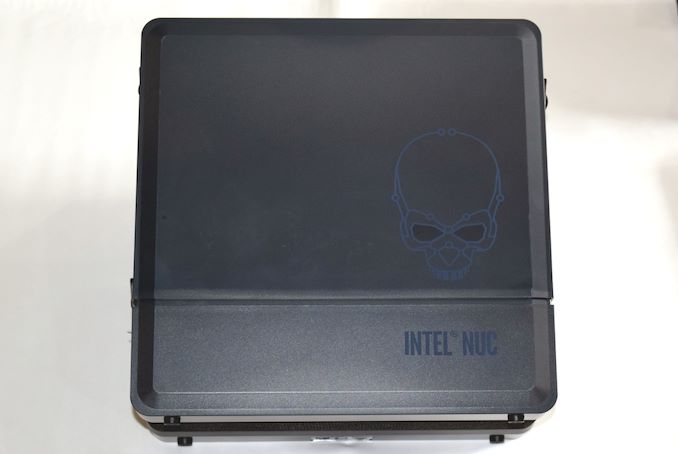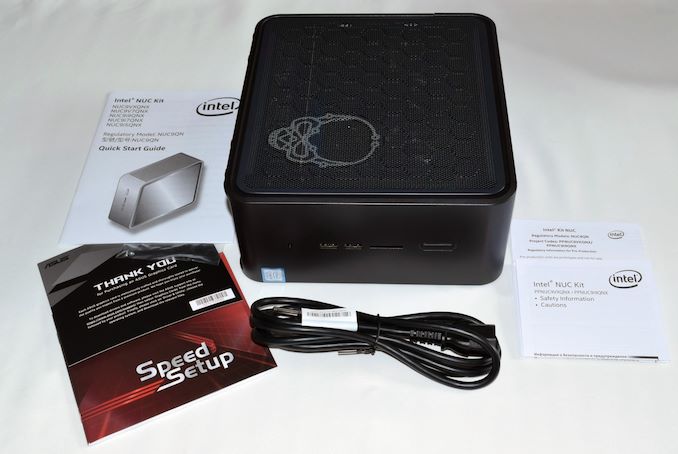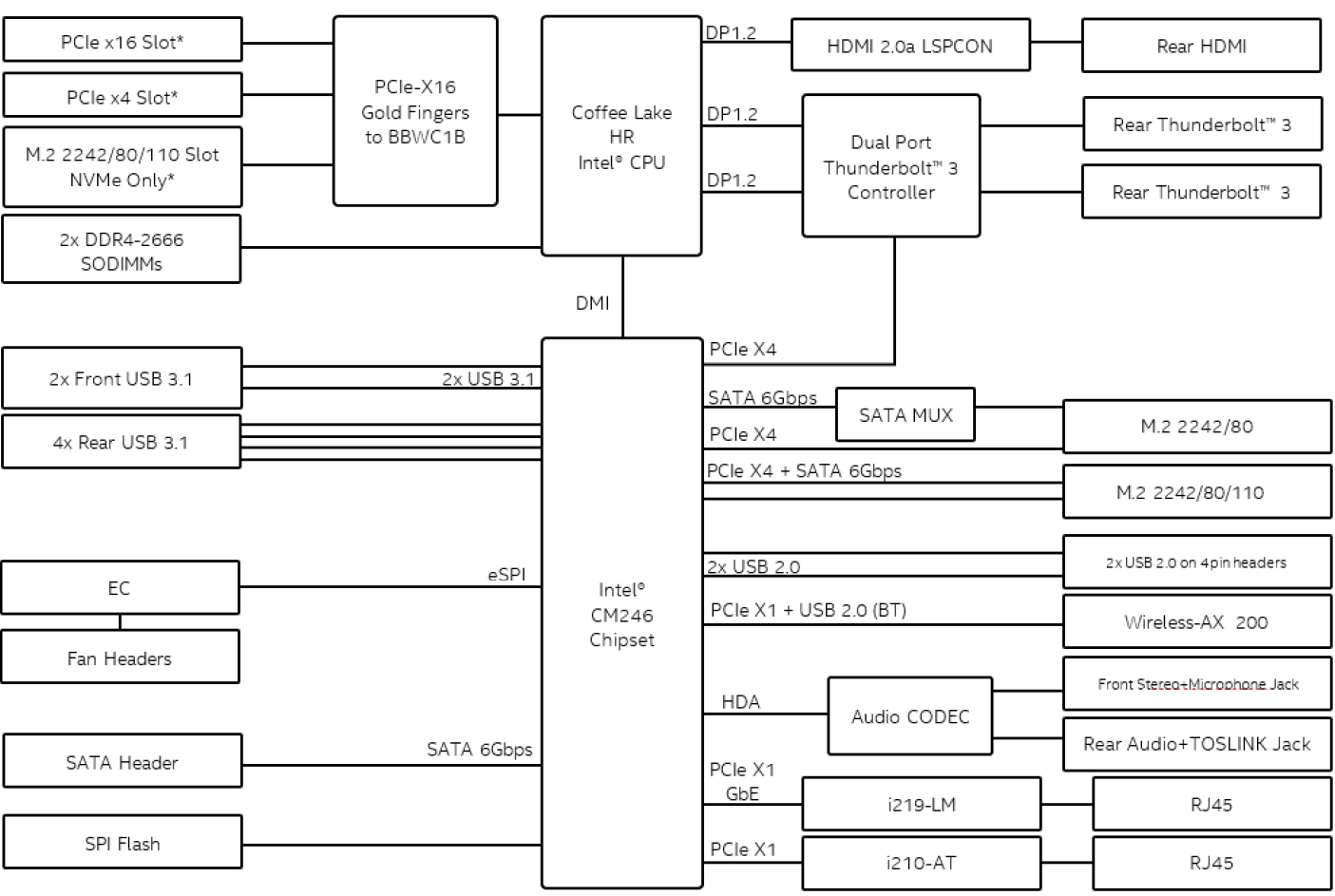Intel Ghost Canyon NUC9i9QNX Review: NUC 9 Extreme Realizes the SFF Dream
by Ganesh T S on April 16, 2020 8:05 AM ESTSetup Notes and Platform Analysis
The NUC 9 Extreme Kit is packaged in a fancy hard casing, signifying its premium nature. Since we had a system configuration essentially ready to benchmark, the package contents only included a few manuals and regulatory information notes along with a US power cord.
We noted the re-design of the Visual BIOS in our Frost Canyon NUC review. The NUC9i9QNX also uses the same re-designed interface. Unlike the mainstream NUC10i7FNH, the NUC9i9QNX has a few enthusiast options including the ability to fine-tune the DRAM timing parameters from a performance perspective. The entire gamut of options available in the latest BIOS (v0034) of the NUC9i9QNX is brought out in the gallery below.
The specifications of our Intel NUC9i9QNX review configuration are summarized in the table below.
| Intel NUC9i9QNX (Ghost Canyon) Specifications | |
| Processor | Intel Core i9-9980HK Coffee Lake-H, 8C/16T, 2.4 (5.0) GHz 16MB L2+L3, 14nm (optimized), 45W TDP |
| Memory | Kingston HyperX KHX3200C20S4/8G DDR4 SODIMM 17-19-19-35 @ 2666 MHz 2x8 GB |
| Graphics | ASUS Dual GeForce RTX 2070 MINI 8GB GDDR6 Intel UHD Graphics 630 |
| Disk Drive(s) | Intel SSD 905p Optane SSDPEL1D380GA (380 GB; M.2 Type 22110 PCIe 3.0 x4 NVMe; Optane / 3D XPoint) Kingston KC2000 SKC2000M81000G (1TB; M.2 Type 2280 PCIe 3.0 x4 NVMe; Toshiba 96L 3D TLC; Silicon Motion SM2262EN Controller) |
| Networking | Intel Wi-Fi 6 AX200 (2x2 802.11ax - 2400 Mbps) 1x Intel I219-LM Gigabit Ethernet Adapter 1x Intel I210 Gigabit Ethernet Adapter |
| Audio | 3.5mm Audio Jack (Front) Optical TOSLINK output (Rear) Capable of 5.1/7.1 digital output with HD audio bitstreaming (HDMI) |
| Miscellaneous I/O Ports | 1x UHS-II SDXC Slot (Front) 2x USB 3.2 Gen 2 (10 Gbps) Type-A (Front) 4x USB 3.2 Gen 2 (10 Gbps) Type-A (Rear) 2x Thunderbolt 3 (40 Gbps) Type-C (Rear) |
| Operating System | Retail unit is barebones, but we installed Windows 10 Enterprise x64 |
| Pricing (As configured) | $2810 |
| Full Specifications | Intel NUC9i9QNX Specifications |
The block diagram of the components of the NUC9i9QNX are presented in the diagram below.
One of the aspects that needs to be pointed out here is that the 2x Front USB 3.1 ports specified in the diagram above are physically the ones on the Compute Element, and not on the front panel of the chassis. The diagram does bring out the PCIe lanes bifurcation in the baseboard, though.
Our review sample came with Windows 10 Home x64 pre-installed, but, we wiped the drive and installed Windows 10 Enterprise x64 1909 along with the March 2020 cumulative updates prior to benchmarking. Our initial benchmarking and reports collection was done without opening up the system. The AIDA64 system report for the hardware configuration supplied by Intel provided the following information:
- [ North Bridge: Intel Comet Lake-H IMC ]:
- PCIe 3.0 x8 port #2 In Use @ x8 (nVIDIA GeForce RTX 2070 Video Adapter, nVIDIA TU106 - High Definition Audio Controller)
- PCIe 3.0 x4 port #4 In Use @ x4 (Intel Optane SSD 900p NVMe Controller)
- [ South Bridge: Intel Cannon Point CM246 ]:
- PCIe 3.0 x1 port #1 In Use @ x1 (Intel Wi-Fi 6 AX200 160MHz Wireless Network Adapter)
- PCIe 3.0 x4 port #5 In Use @ x4 (Intel Titan Ridge Thunderbolt 3 Controller)
- PCIe 3.0 x4 port #9 In Use @ x4 (Silicon Motion SM2262 PCIe 3.0 x4 NVMe 1.3 SSD Controller - Kingston KC2000)
- PCIe 3.0 x1 port #14 In Use @ x1 (Intel I210 Gigabit Network Connection)
We were puzzled by the discrete GPU operating in x8 mode instead of x16 (as it could affect gaming performance). After reaching out to Intel, we got additional context for the review configuration. As noted briefly a bit earlier, the M.2 slot on the baseboard is directly attached to the CPU, using PCIe lanes from it rather than off of the chipset. So the power-hungry, but high-performance 905p Optane drive in the baseboard slot makes sense in that context, as Intel is giving it the best possible (and least contested) connection to the CPU in order to highlight the capabilities of CPU-attached storage.
As evident from the block diagram, the Thunderbolt ports, USB ports, and the M.2 slots on the Compute Element are attached to the chipset, which means sharing the DMI link and its maximum bandwidth of PCIe 3.0 x4 (4GB/s). Which compared to typical systems, is actually a lighter load than usual; by hanging the Optane drive off of the CPU, there's less contention for the rest of the DMI link's resources, enabling additional testing areas such as elimination of noise from Thunderbolt 3 testing and allowing for RAID-0/1 on the Compute Element. Overall this opens up a few different configuration options, so in order to highlight the pros and cons of splitting the x16 slot with a SSD, we also tested the NUC with the Optane drive hanging off of the PCH, giving the video card a full x16 slot's worth of bandwidth. This is noted as x16 in the rest of the review to signify the operation of the RTX 2070 in x16 mode.
The AIDA64 system report for the x16 configuration has a slightly tweaked version of the PCIe lane usage specified earlier:
- [ North Bridge: Intel Comet Lake-H IMC ]:
- PCIe 3.0 x16 port #2 In Use @ x8 (nVIDIA GeForce RTX 2070 Video Adapter, nVIDIA TU106 - High Definition Audio Controller)
- [ South Bridge: Intel Cannon Point CM246 ]:
- PCIe 3.0 x1 port #1 In Use @ x1 (Intel Wi-Fi 6 AX200 160MHz Wireless Network Adapter)
- PCIe 3.0 x4 port #5 In Use @ x4 (Intel Titan Ridge Thunderbolt 3 Controller)
- PCIe 3.0 x4 port #9 In Use @ x4 (Intel Optane SSD 900p NVMe Controller)
- PCIe 3.0 x1 port #14 In Use @ x1 (Intel I210 Gigabit Network Connection)
- PCIe 3.0 x4 port #21 In Use @ x4 (Silicon Motion SM2262 PCIe 3.0 x4 NVMe 1.3 SSD Controller - Kingston KC2000)
The NUC9i9QNX is a relatively unique system. We have evaluated SFF systems with discrete GPUs in the last few years. Systems such as the Hades Canyon NUC came with a co-packaged discrete GPU leaving no scope for the end-user to upgrade the graphics performance without buying an entirely new computer. We've also had systems with a real discrete GPU such as the ASRock DeskMini Z370 GTX1060 and the Zotac ZBOX MAGNUS EN1080K. Theoretically, users could upgrade the installed MXM card to get better graphics performance, but practically speaking, MXM card upgrades are incredibly rare and almost never officially supported by system manufacturers.
This leaves us with one true precursor to the Ghost Canyon NUC - the Zotac ZBOX MAGNUS EK71080. This 5.7L compact gaming powerhouse internally sports a single-fan version of the Zotac GTX 1080 Mini complete with the external PCIe power connector, and nothing preventing the end-user from replacing it with a similar-sized GPU. Obviously, Zotac would not officially support this, but it only serves to show that accommodation of user-replaceable discrete GPUs in compact SFF systems has been possible before. The Compute Element initiative from Intel has been accompanied by the creation of an ecosystem where add-in card vendors now have an incentive to create discrete GPU cards within the 202mm x 131mm form-factor. Along with chassis designs like the one in the NUC9i9QNX, this has now enabled sub-5L systems capable of sporting powerful user-replaceable discrete GPUs.
In the table below, we have an overview of the various systems that we are comparing the Intel NUC9i9QNX against. Note that they may not belong to the same market segment. The relevant configuration details of the machines are provided so that readers have an understanding of why some benchmark numbers are skewed for or against the Intel NUC9i9QNX when we come to those sections.
| Comparative PC Configurations | ||
| Aspect | Intel NUC9i9QNX (Ghost Canyon) | |
| CPU | Intel Core i9-9980HK | Intel Core i9-9980HK |
| GPU | ASUS Dual GeForce RTX 2070 MINI 8GB GDDR6 Intel UHD Graphics 630 |
ASUS Dual GeForce RTX 2070 MINI 8GB GDDR6 Intel UHD Graphics 630 |
| RAM | Kingston HyperX KHX3200C20S4/8G DDR4 SODIMM 17-19-19-35 @ 2666 MHz 2x8 GB |
Kingston HyperX KHX3200C20S4/8G DDR4 SODIMM 17-19-19-35 @ 2666 MHz 2x8 GB |
| Storage | Intel SSD 905p Optane SSDPEL1D380GA (380 GB; M.2 Type 22110 PCIe 3.0 x4 NVMe; Optane / 3D XPoint) Kingston KC2000 SKC2000M81000G (1TB; M.2 Type 2280 PCIe 3.0 x4 NVMe; Toshiba 96L 3D TLC; Silicon Motion SM2262EN Controller) |
Intel SSD 905p Optane SSDPEL1D380GA (380 GB; M.2 Type 22110 PCIe 3.0 x4 NVMe; Optane / 3D XPoint) Kingston KC2000 SKC2000M81000G (1TB; M.2 Type 2280 PCIe 3.0 x4 NVMe; Toshiba 96L 3D TLC; Silicon Motion SM2262EN Controller) |
| Wi-Fi | Intel Wi-Fi 6 AX200 (2x2 802.11ax - 2400 Mbps) |
Intel Wi-Fi 6 AX200 (2x2 802.11ax - 2400 Mbps) |
| Price (in USD, when built) | $1553 (barebones) $2810 (as configured) |
$1553 (barebones) $2810 (as configured) |



















109 Comments
View All Comments
Deicidium369 - Saturday, April 18, 2020 - link
No, Jimmy it's not made to impress you, I could not care less about what you think. The point is that I am not an Intel fanboy - I prefer Intel AFTER taking the best AMD has to offer in consideration. For that year back when the AMD Athlon 2400XP (pretty sure that was the model) I was sure my next PC would be AMD also - then Core dropped ... and the Sun set on that idea.So when Ryzen released - I put together a 1700 system, It was OK but not great - good for budget builds. The 2700X was very good, few issues, good performance, paired that with a Vega VII - and that was just meh. The 3950 is not bad, but nothing special - I do not have any use for a HEDT system - we migrated from LGA2011v3 to Intel Scalable Xeon for our engineering workstations - although the 2nd socket never got populated - still was the solid choice.
You should try to add something other than being a reflexive little troll - all you do, as does qasar is to call people fanboys - but ALL you add to the conversation is calling other people fanboy - when you 2 are the biggest fanboys I have run into. Kiddies you shouldn't be putting so much of your own self worth into what some corporation is doing - maybe when you get older you will get some perspective - back in my day I fought the Mac vs Atari ST vs Amiga wars, and later the Netscape vs IE wars - so I understand the mentality - but that 30 years ago.
Now run along, Jimmy and clean the basement.
Yeah you mean the guy who could not find the slide that said full scene RT in the cloud? Replied with the Slide that he could not find - and he later PM'd me, And still did not refute a single thing I said. So fight your own battles.
Korguz - Sunday, April 19, 2020 - link
" I am not an Intel fanboy " yea right, your post reek of it, even though you keep saying other wise.and in return, all you do is call people names and insult them cause all you have left, you cant give proof of ANYTHING you say, cause it is all your personal opinion and bias. thats funny, seems a of people refuted what you said, even Johan. what the point of calling me jimmy anyway, does it make you feel better about yourself some how ?
Korguz - Sunday, April 19, 2020 - link
and your " facts " are still BS, thats why you havent replied to that thread, or the one on tom's, cause you have nothing."You should try to add something other than being a reflexive little troll " and so should you, try posting some links or sources to back up what you say. " but ALL you add to the conversation is calling other people fanboy " and all you do is instult people and call them names, point is ?
" Kiddies you shouldn't be putting so much of your own self worth into what some corporation is doing " ha, you should talk. looks like you were refuted on tom's so you came here to spread your BS instead.
Korguz - Sunday, April 19, 2020 - link
johan = jarredOperandi - Friday, April 17, 2020 - link
LOL, and you think this is going to sell?If this thing wasn't over priced at least the vast majority of the work of building a SFC system would be done and that would be small win. Still wildly inferior to what you can do with off the shelf iTX hardware (Intel or AMD, dosn't mater) but it would be something. As it is this a over priced cluster fuck disaster of a design that dose nothing you can't do with off the shelf parts. Good job Intel.
Deicidium369 - Friday, April 17, 2020 - link
I honestly have NO CLUE what the exact use case for this system is - Intel calls it a NUC - I DO NOT consider this to be a NUC system... Again, no clue.Korguz - Friday, April 17, 2020 - link
" work on something that would, you know, sell. " that implies you think this would sell.Deicidium369 - Sunday, April 19, 2020 - link
Jimmy - go clean the basement. You seem to be following me - look bud - I don't care what you are into, I am married and your obvious infatuation is starting to creep me out. Seriously - stay away.Korguz - Sunday, April 19, 2020 - link
of frank, when i am done that, i will help you clean out the garage. cause obviously, you are incapable of thatSpunjji - Friday, April 24, 2020 - link
Your posts here are the worst. 🤦♂️